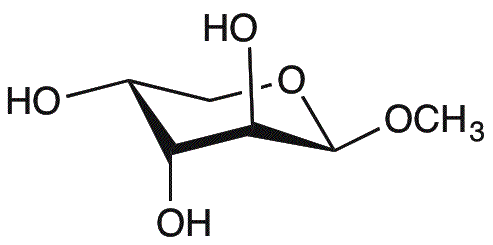Methyl b-D-arabinopyranoside is widely utilized in research focused on:
- Glycobiology Studies: This compound serves as a valuable tool for studying carbohydrate-protein interactions, helping researchers understand cellular recognition processes.
- Pharmaceutical Development: It acts as a building block in the synthesis of glycosylated drugs, enhancing their efficacy and stability in therapeutic applications.
- Food Industry: Used as a sweetening agent and flavor enhancer, it provides a natural alternative to synthetic sweeteners, appealing to health-conscious consumers.
- Biotechnology: Methyl b-D-arabinopyranoside is employed in the production of biofuels and bioplastics, contributing to sustainable practices in the industry.
- Cosmetic Formulations: Its moisturizing properties make it a popular ingredient in skincare products, offering benefits for hydration and skin health.
General Information
Properties
Safety and Regulations
Applications
Methyl b-D-arabinopyranoside is widely utilized in research focused on:
- Glycobiology Studies: This compound serves as a valuable tool for studying carbohydrate-protein interactions, helping researchers understand cellular recognition processes.
- Pharmaceutical Development: It acts as a building block in the synthesis of glycosylated drugs, enhancing their efficacy and stability in therapeutic applications.
- Food Industry: Used as a sweetening agent and flavor enhancer, it provides a natural alternative to synthetic sweeteners, appealing to health-conscious consumers.
- Biotechnology: Methyl b-D-arabinopyranoside is employed in the production of biofuels and bioplastics, contributing to sustainable practices in the industry.
- Cosmetic Formulations: Its moisturizing properties make it a popular ingredient in skincare products, offering benefits for hydration and skin health.
Documents
Safety Data Sheets (SDS)
The SDS provides comprehensive safety information on handling, storage, and disposal of the product.
Product Specification (PS)
The PS provides a comprehensive breakdown of the product’s properties, including chemical composition, physical state, purity, and storage requirements. It also details acceptable quality ranges and the product's intended applications.
Certificates of Analysis (COA)
Search for Certificates of Analysis (COA) by entering the products Lot Number. Lot and Batch Numbers can be found on a product’s label following the words ‘Lot’ or ‘Batch’.
Numéro de catalogue
Numéro de lot/série
Certificates Of Origin (COO)
This COO confirms the country where the product was manufactured, and also details the materials and components used in it and whether it is derived from natural, synthetic, or other specific sources. This certificate may be required for customs, trade, and regulatory compliance.
Numéro de catalogue
Numéro de lot/série
Safety Data Sheets (SDS)
The SDS provides comprehensive safety information on handling, storage, and disposal of the product.
DownloadProduct Specification (PS)
The PS provides a comprehensive breakdown of the product’s properties, including chemical composition, physical state, purity, and storage requirements. It also details acceptable quality ranges and the product's intended applications.
DownloadCertificates of Analysis (COA)
Search for Certificates of Analysis (COA) by entering the products Lot Number. Lot and Batch Numbers can be found on a product’s label following the words ‘Lot’ or ‘Batch’.
Numéro de catalogue
Numéro de lot/série
Certificates Of Origin (COO)
This COO confirms the country where the product was manufactured, and also details the materials and components used in it and whether it is derived from natural, synthetic, or other specific sources. This certificate may be required for customs, trade, and regulatory compliance.


